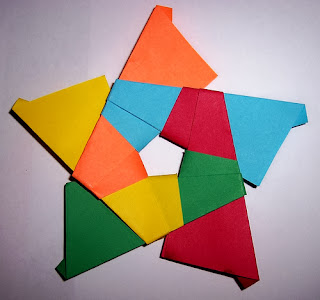Since the Modular Origami's field is somehow w-i-d-e, I'll divide it into a few posts, so today I'll just make a general introduction towards it.
Let's get started :D
Top Rules for Origamis
#2 Complete the model without using any external materials to maintain the model's structure (glue/ thread)
 |
| Kusudama Paradigma Made up of 30 modular units, they interlock each other so that the model could maintain its structure without glues/ threads |
What really is Modular Origami?
Modular Origamis are Origami models that are designed mostly based on polygonal shapes and built up using exactly identical modular units and linking them together in a repetitive manner to form an origami structure, WITHOUT glue/ thread
It could be in flat or three dimensional form.
It could be in flat or three dimensional form.
 |
| Pentagonal Star [ Flattened Form ] |
Designed and folded
by Christine Edison
Folded by Me
From what I've studied, by here I'll divide three-dimensional Modular Origamis into a two different categories,
Example:
Kusudama Paradigma
Kusudama Paradigma
(pic above)
*Versailles Kusudama
(pic on right)
*Little Roses Kusudama
*Little Roses Kusudama
(pic below)
*[ Image taken from www.goorigami.com ]
| Hollow Sonobe |
-Sonobe
Example:
Stellated Icosahedron Star
(pic above)
*Hollow Sonobe
(pic on left)
*[ Image taken from
leezarainboeveins.deviantart.com ]
Coming up post will be talking about either one of the Modular Origamis category I've stated above,
so if you wanted to know more, stay tuned!
Have a great day and good bye :D

No comments:
Post a Comment